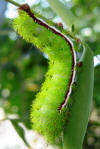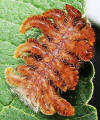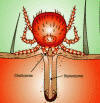Discover Florida Nature
It's time to explore the natural Florida


|
|
|
|
|
Stinging caterpillars frequently found in Florida are the puss
caterpillar, saddleback caterpillar, Io moth caterpillar, and the hag
moth caterpillar. These caterpillars feed on vegetation and have spines
which can break off in the skin. When the spines break, a toxin flows
from the spines onto the skin, causing a burning sensation. Io
Moth Caterpillar- This is a pale green caterpillar with yellow
and red stripes. It often exceeds 2" in length and is fairly stout
bodied. The nettling organs are borne on fleshy tubercles, and the
spines are usually yellow with black tips. With many-branched spines
full of poison, the Io Moth caterpillar is ready for a fight. Eggs are
laid in clusters, so earliest instar caterpillars will be seen in
bunches. They start larval life a dark brown, and gradually molt from
brown to orange, then tan, and finally to this green color. Io moth
caterpillars feed on a wide range of plants; however ixora and roses are
favorite hosts. Io
Moth Caterpillar- This is a pale green caterpillar with yellow
and red stripes. It often exceeds 2" in length and is fairly stout
bodied. The nettling organs are borne on fleshy tubercles, and the
spines are usually yellow with black tips. With many-branched spines
full of poison, the Io Moth caterpillar is ready for a fight. Eggs are
laid in clusters, so earliest instar caterpillars will be seen in
bunches. They start larval life a dark brown, and gradually molt from
brown to orange, then tan, and finally to this green color. Io moth
caterpillars feed on a wide range of plants; however ixora and roses are
favorite hosts. Hag
Moth Caterpillar-
This caterpillar is light to dark brown in color. It has nine pairs of
variable length lateral processes that bear the stinging hairs. These
processes are curved and twisted and likened by some to the disheveled
hair of a hag, for which it is aptly names. The hag moth caterpillar is
found on various forest trees and ornamental shrubs, but is not as
common as the other stinging species. Hag
Moth Caterpillar-
This caterpillar is light to dark brown in color. It has nine pairs of
variable length lateral processes that bear the stinging hairs. These
processes are curved and twisted and likened by some to the disheveled
hair of a hag, for which it is aptly names. The hag moth caterpillar is
found on various forest trees and ornamental shrubs, but is not as
common as the other stinging species.  Chiggers-
Probably no creature on earth can cause as much torment for its size
than the tiny chigger. Chiggers or "red bugs" are the larvae of mites
belonging to the family Trombiculidae. In humans, chiggers can cause
intense itching and small reddish welts on the skin Chigger mites are
about 1/20 inch long, usually bright red, have hairy bodies, and travel
rapidly. Chigger larvae do not burrow into the skin, nor suck blood.
Chiggers attach themselves to the skin, hair follicles or pores by
inserting their piercing mouthparts. When chiggers attach to humans,
they are not usually noticed for some time. During feeding, they inject
a fluid into the skin which dissolves tissue. Chiggers feed by sucking
up the liquified tissues. Chiggers-
Probably no creature on earth can cause as much torment for its size
than the tiny chigger. Chiggers or "red bugs" are the larvae of mites
belonging to the family Trombiculidae. In humans, chiggers can cause
intense itching and small reddish welts on the skin Chigger mites are
about 1/20 inch long, usually bright red, have hairy bodies, and travel
rapidly. Chigger larvae do not burrow into the skin, nor suck blood.
Chiggers attach themselves to the skin, hair follicles or pores by
inserting their piercing mouthparts. When chiggers attach to humans,
they are not usually noticed for some time. During feeding, they inject
a fluid into the skin which dissolves tissue. Chiggers feed by sucking
up the liquified tissues. Puss
Caterpillar-
Puss caterpillars are a convex, stout bodied larva, almost 1" long when
mature and completely covered with gray to brown hairs. Under the soft
hairs are stiff spines that are attached to poison glands. When touched,
these poisonous spines break off in the skin and cause severe pain. Puss
caterpillars feed on a variety of broadleaf trees and shrubs, but prefer
oaks and citrus. In Florida,
there appear to be two generations per year, one in spring and the other
in the fall. Natural enemies keep these caterpillars at low numbers
during most years; however, they periodically become numerous. Puss
Caterpillar-
Puss caterpillars are a convex, stout bodied larva, almost 1" long when
mature and completely covered with gray to brown hairs. Under the soft
hairs are stiff spines that are attached to poison glands. When touched,
these poisonous spines break off in the skin and cause severe pain. Puss
caterpillars feed on a variety of broadleaf trees and shrubs, but prefer
oaks and citrus. In Florida,
there appear to be two generations per year, one in spring and the other
in the fall. Natural enemies keep these caterpillars at low numbers
during most years; however, they periodically become numerous. Centipedes-
Centipedes and millipedes are commonly seen in yards and occasionally
enter homes. Centipedes are many-legged animals and belong to a group
of animals called Chilopods. They are usually brownish, flattened
animals with many body segments. Most of the body segments have one pair
of legs. Centipedes are fast runners and may vary in length from one to
six inches. They have one pair of antennae or "feelers" that are easily
seen. Centipedes have poorly developed eyes and are most active at
night. They are active predators and feed mainly on insects and spiders.
All centipedes have venom glands to immobilize their prey. The jaws of
the smaller local species cannot penetrate human skin; however, the
larger species may inflict painful bites. Centipedes-
Centipedes and millipedes are commonly seen in yards and occasionally
enter homes. Centipedes are many-legged animals and belong to a group
of animals called Chilopods. They are usually brownish, flattened
animals with many body segments. Most of the body segments have one pair
of legs. Centipedes are fast runners and may vary in length from one to
six inches. They have one pair of antennae or "feelers" that are easily
seen. Centipedes have poorly developed eyes and are most active at
night. They are active predators and feed mainly on insects and spiders.
All centipedes have venom glands to immobilize their prey. The jaws of
the smaller local species cannot penetrate human skin; however, the
larger species may inflict painful bites. Pillbugs
and Sowbugs- Pillbugs, and sowbugs are slow-moving, crawling
arthropods. They require high moisture and are most active at night.
When resting during the day, they may be found under trash, rocks,
boards, under decaying vegetation, or just beneath the soil surface. A
heavy infestation indoors usually indicates a large population outdoors.
Mulches, grass clippings, and leaf litter often provide the decaying
organic matter they need to survive. Both bugs are found throughout
Florida. They Pillbugs
and Sowbugs- Pillbugs, and sowbugs are slow-moving, crawling
arthropods. They require high moisture and are most active at night.
When resting during the day, they may be found under trash, rocks,
boards, under decaying vegetation, or just beneath the soil surface. A
heavy infestation indoors usually indicates a large population outdoors.
Mulches, grass clippings, and leaf litter often provide the decaying
organic matter they need to survive. Both bugs are found throughout
Florida. They
 are
wingless, oval or slightly elongated arthropods about half an inch in
length and slate-gray in color with body segments resembling armored
plates. Pillbugs or "rolly-pollies" lack the tail-like appendages that
sowbugs have and can roll into a tight ball. Sowbugs are often called
woodlice and possess two tail-like appendages, seven pairs of legs, and
well-developed eyes. They are incapable of rolling into a tight ball. are
wingless, oval or slightly elongated arthropods about half an inch in
length and slate-gray in color with body segments resembling armored
plates. Pillbugs or "rolly-pollies" lack the tail-like appendages that
sowbugs have and can roll into a tight ball. Sowbugs are often called
woodlice and possess two tail-like appendages, seven pairs of legs, and
well-developed eyes. They are incapable of rolling into a tight ball.  Earwigs-
Earwigs are beetle-like, short-winged, fast moving insects about
one-half to one inch in length. Earwigs are usually dark brown and have
a pair of pincer-like appendages at the tip of the abdomen. The name
earwig is derived from an old superstition that these insects enter
peoples' ears. This idea is entirely unfounded because earwigs are
harmless to man. Some earwig species have scent glands from which they
can squirt a foul-smelling liquid. This is probably used for protection;
however, it makes them very unpleasant when accidentally or purposely
mashed. Earwigs are active at night. Earwigs usually hide in cracks,
crevices, under bark or in similar places during the day. Earwigs are
usually scavengers in their feeding habits, but occasionally feed on
plants. Earwigs-
Earwigs are beetle-like, short-winged, fast moving insects about
one-half to one inch in length. Earwigs are usually dark brown and have
a pair of pincer-like appendages at the tip of the abdomen. The name
earwig is derived from an old superstition that these insects enter
peoples' ears. This idea is entirely unfounded because earwigs are
harmless to man. Some earwig species have scent glands from which they
can squirt a foul-smelling liquid. This is probably used for protection;
however, it makes them very unpleasant when accidentally or purposely
mashed. Earwigs are active at night. Earwigs usually hide in cracks,
crevices, under bark or in similar places during the day. Earwigs are
usually scavengers in their feeding habits, but occasionally feed on
plants. Wheel
Bug (Arilus cristatus)- The wheel bug does indeed look like a
mechanical device, from its long legs that extend in jerky, robot-like
motions to the large cog-like structure on its back that gives rise to
its common name. Wheel Bugs are True Bugs classified in the Hemiptera,
an order that includes such diverse insects as Stink Bugs, Water
Striders, and Bed Bugs. Although the generic term "bug" is bestowed on
all sorts of insects, it is scientifically accurate only when applied to
True Bugs. Give Wheel bugs a wide birth, their sting really hurts! Wheel
Bug (Arilus cristatus)- The wheel bug does indeed look like a
mechanical device, from its long legs that extend in jerky, robot-like
motions to the large cog-like structure on its back that gives rise to
its common name. Wheel Bugs are True Bugs classified in the Hemiptera,
an order that includes such diverse insects as Stink Bugs, Water
Striders, and Bed Bugs. Although the generic term "bug" is bestowed on
all sorts of insects, it is scientifically accurate only when applied to
True Bugs. Give Wheel bugs a wide birth, their sting really hurts! |
|
|
Advertise | Privacy Statement | Contact | Alaska Nature | Michael Arnold Art| Dog Encyclopedia | Dog Encyclopedia| |
|